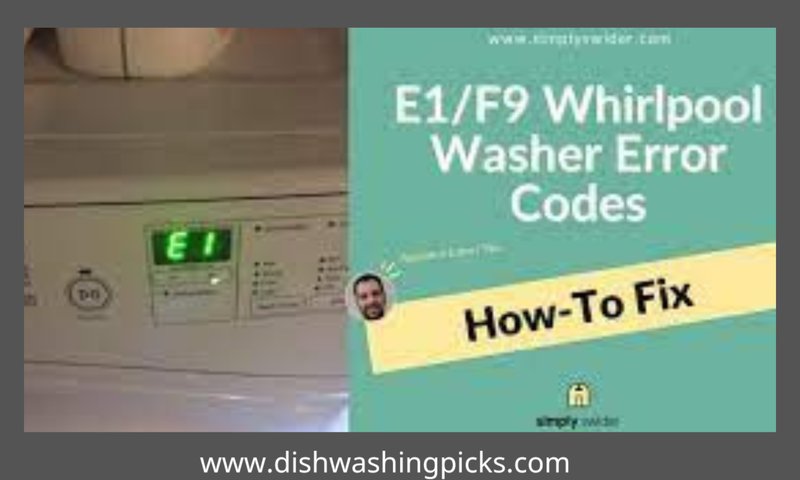
The good news is, you don’t have to be an appliance expert to tackle or prevent this error. With some basic understanding and regular maintenance, you can keep your dishwasher running smoothly. Having a game plan for preventing the E1 error code not only saves you time and money but also extends the life of your dishwasher. Let’s walk through the steps and tips to make sure this error is nothing but a memory.
Understanding the E1 Error Code
Before you can prevent an issue, it’s important to understand what you’re dealing with. An error code E1 on a KitchenAid dishwasher usually signals there’s a problem with water flow — either not enough water is entering the machine, or it’s taking too long for the water to drain. Imagine a sink that’s either not filling quickly enough or one that’s draining slowly. Both situations can cause a bit of a mess if unattended.
Now, you might be wondering, “Why does this happen?” Several factors could lead to an E1 error. It could be a clogged or kinked water inlet hose, a malfunctioning water inlet valve, or even issues with the dishwasher’s pump. Sometimes, just like clogged arteries can cause heart trouble, these pathways can get blocked or malfunction, disrupting the entire system.
So, what’s the impact of ignoring this issue? Well, aside from the inconvenience of a half-clean load of dishes, persistent E1 errors could lead to more serious complications, such as water leaks or even damage to your dishwasher. It’s like ignoring a slow leak in your car’s tire — sooner or later, it’s going to become a bigger problem.
Regular Maintenance for a Healthy Dishwasher
Preventing an E1 error starts with regular maintenance. Think of it like giving your car a routine check-up to keep it running smoothly. First, make it a habit to inspect and clean the dishwasher’s filter. The filter catches food particles and other debris, and when it gets clogged, it can impede water flow. A blocked filter is like trying to drink through a straw with something stuck inside — it just doesn’t work very well.
Next, take a look at the dishwasher’s spray arms. These are responsible for circulating water throughout your dishwasher. If they get clogged or blocked, water flow can be restricted, contributing to an E1 error. Imagine watering your garden with a kinked hose — not ideal, right? Remove and rinse the spray arms every few months to ensure they’re free of debris.
Lastly, don’t forget to check the water inlet valve and hose. A faulty valve or a kinked hose can prevent water from entering the machine efficiently. Unclogging these is akin to unclogging a drain in your home. Ensuring that everything is clear and functional will prevent those pesky error codes.
Effective Usage Tips
Using your dishwasher correctly is just as important as maintaining it. Always load your dishwasher properly, allowing enough space between dishes. Overcrowding can block water flow, much like an overloaded backpack makes it hard to find what you need. Make sure large items don’t obstruct the spray arms, as this can affect the cleaning process and potentially trigger an E1 error.
Another tip is to ensure you are using the correct detergent and in the right amount. Too much soap can cause residue build-up and interfere with proper drainage. It’s like putting too much oil in your car’s engine — it might seem harmless at first, but it can cause long-term issues.
Run your dishwasher with hot water whenever possible. Hot water helps dissolve food particles more effectively and keeps the insides of your dishwasher cleaner. Think of it as using warm water to wash your hands — it’s more effective at removing dirt and germs compared to cold water.
When to Call a Professional
Despite your best efforts, there may be times when you simply can’t prevent or resolve an E1 error on your own. If you’ve checked all the usual suspects — clean filters, unclogged hoses, and proper loading — and the issue persists, it might be time to seek professional help. A certified technician can perform a thorough check and fix or replace any faulty parts.
Consider this similar to when your car’s check engine light won’t turn off, no matter what you do. A professional mechanic is needed to diagnose and fix the root cause. Likewise, getting a professional to look at your dishwasher can prevent further damage and save you from future headaches.
In conclusion, the key to preventing a KitchenAid dishwasher error code E1 is understanding what causes it and implementing good maintenance and usage practices. By staying vigilant and proactive, you can ensure your dishwasher continues to serve up sparkling clean dishes, hassle-free. Remember, a little attention goes a long way in preserving the health of your trusty kitchen appliance.